Friday, 2 March 2018
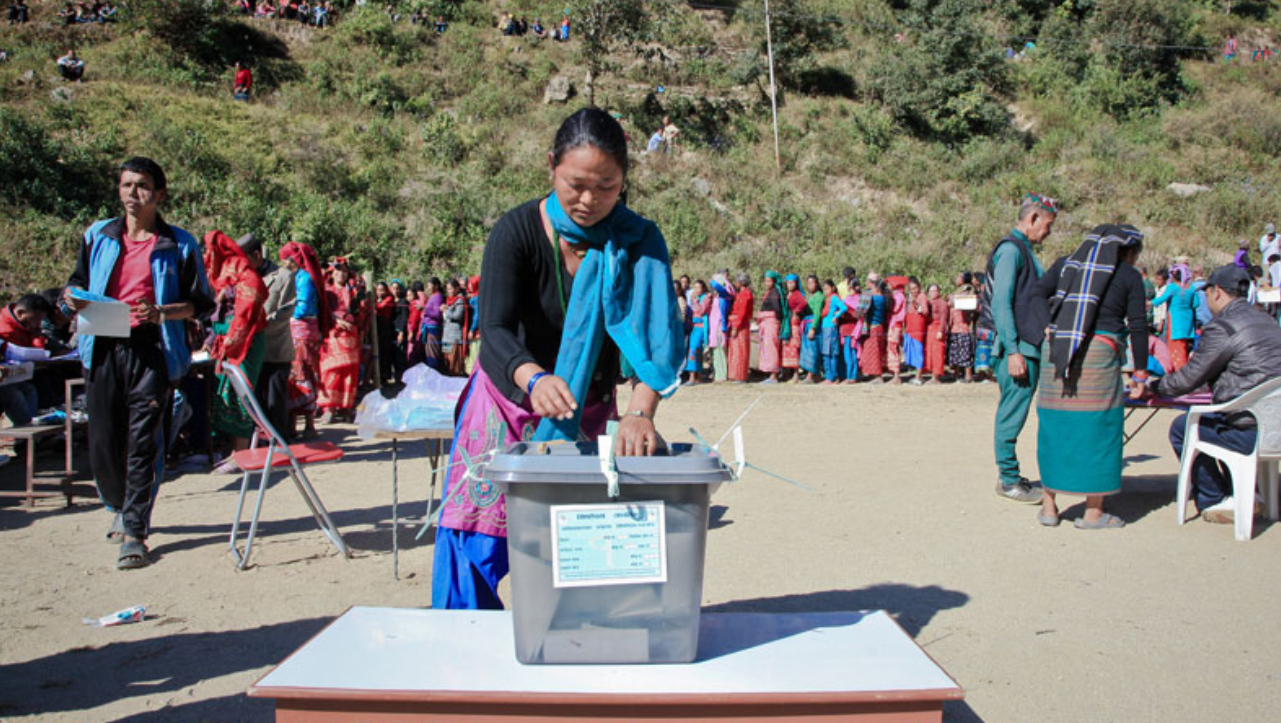
By: Thukten Lama, Project Associate, Accountability Lab – Nepal
Almost 50,000 representatives were elected for Nepal’s new federal structure after nearly 2 decades.
In 2017, Nepal achieved a political milestone by holding its first general elections (local, provincial, and central) after almost two decades. The last time the country elected its local government representatives was in 1997, prior political issues such as the election boycotts, the Royal Massacre in 2002, cessation of a decade-long civil war in 2006 and others prevented successive local elections. The three-tier elections were held following the promulgation of the new constitution in 2015 that replaced constitutional monarchy with the federal structure of governance which aims to end all forms of social, political, and economic discrimination and promotes a form of socialism based on democratic norms and values. The constitution also divided the previously unitary and centralized powers into the hands of the newly created 7 provinces and 754 local bodies.
Election Process and Results
Around 15 million voters elected almost 50 thousand representatives for different local, parliamentary, and provincial assembly positions. The National Assembly, the upper house of the federal parliament of Nepal, comprised of 59 members has been created with 8 members elected from each province and 3 appointed by the president on the recommendation of the government of Nepal. The lower house of the Federal Parliament has 275 seats consisting of 165 representatives chosen through a first-past-the-post (FPTP) system and the remaining 110 representatives elected through a Proportional Representation (PR) system (each party or electoral alliance is required to pass an election threshold of 3% of the overall valid votes to be allocated a seat under the proportional method). Only five major political parties were able to meet the 3% threshold to obtain at least 1 seat in the parliament.
This 3% election threshold for seat allocation under the proportion method could be effective in limiting the number of parties in the parliament and in blocking political polarization. However, it might also restrict emerging and innovative parties with a new agenda and vision for the country. It might also bar honest leaders to be involved in national decision-making processes.

Above are the 5 main parties able to win seats (other smaller political parties were also able to win some seats) An alliance between the CPN [Unified Marxist-Leninist] and the Maoist Centre is poised to be the governing coalition.
Remarkably, the elections were successfully held in different phases and within a span of 8 months. A longer election could have spurred accusations of corruption and problems in election financing.
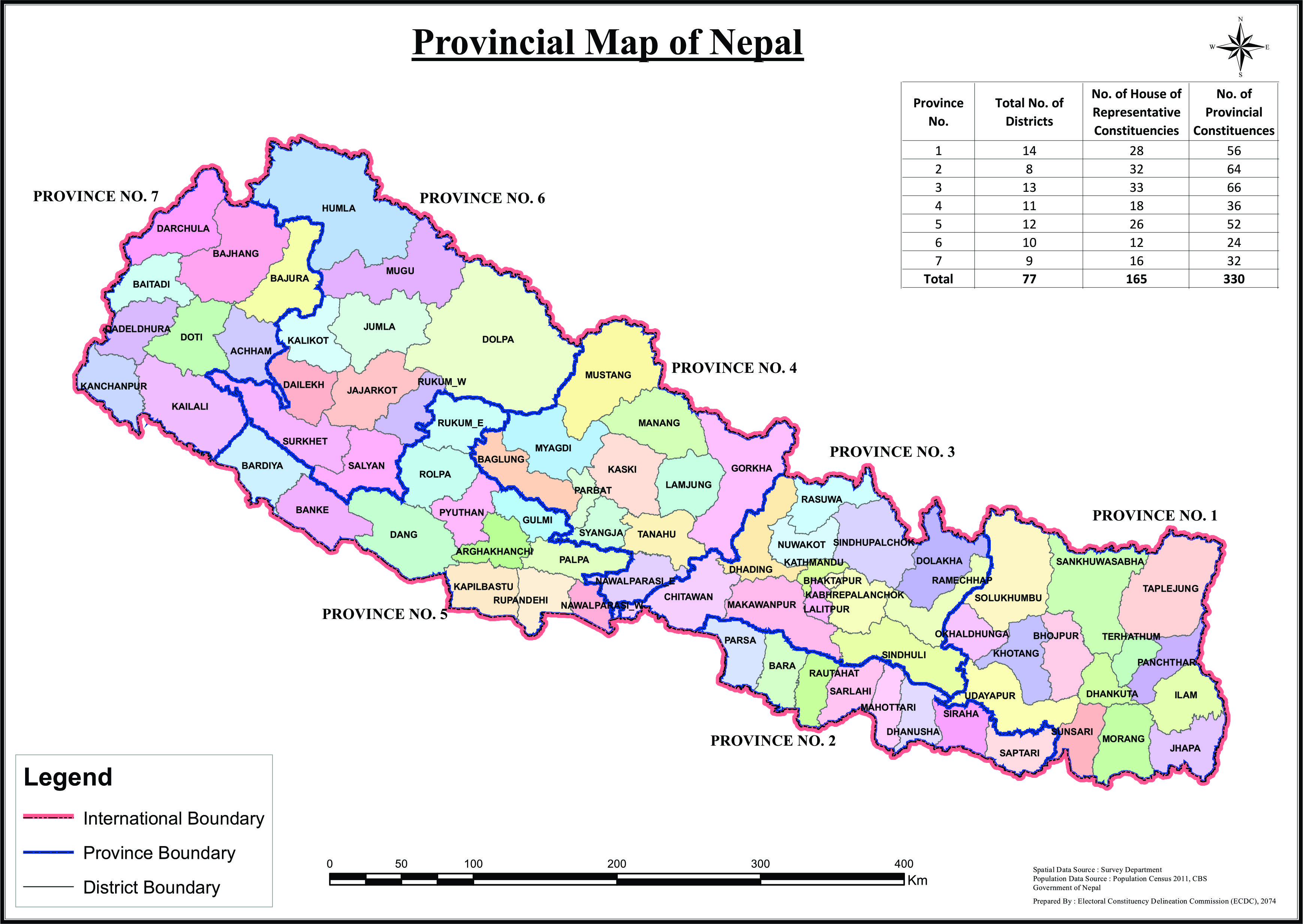 The local elections were conducted in three phases, which were used as references for the parliamentary and provincial elections (these elections were divided into two phases on the provincial level). For the local election, voters elected candidates for seven posts at the local level, including chiefs and deputy chiefs, ward chair, four ward members (two female members) mandating inclusion of a female member from the Dalit community. The election results show that of the 14,339 women elected in the local government, 47.4% are Dalits but their representation outside of their quota is disappointingly minimal. Only 2% of the 754 positions for mayor and chairperson positions went to women candidates despite a 50% quota reserved for women; 91% of the deputy positions did go, however, to women candidates.
The local elections were conducted in three phases, which were used as references for the parliamentary and provincial elections (these elections were divided into two phases on the provincial level). For the local election, voters elected candidates for seven posts at the local level, including chiefs and deputy chiefs, ward chair, four ward members (two female members) mandating inclusion of a female member from the Dalit community. The election results show that of the 14,339 women elected in the local government, 47.4% are Dalits but their representation outside of their quota is disappointingly minimal. Only 2% of the 754 positions for mayor and chairperson positions went to women candidates despite a 50% quota reserved for women; 91% of the deputy positions did go, however, to women candidates.
Based on estimates, the voter turnout for the local level, and parliamentary and provincial levels were around 73% and 65% respectively.
Welcoming the Prospects of Federalism
The three-tier election, which is also the first election after the ratification of the new constitution, is a groundbreaking achievement in Nepal’s long pursuit for democracy. However, the strength of the new constitution that adopts principles of republicanism, federalism, secularism, and inclusiveness is yet to be tested. Despite of a few prominent groups of the Madhesh minority community-based parties, which attempted to boycott the local elections and launched anti-constitution protests demanding amendments to the constitution to meet the demands of the Madhesis, the election was largely successful. There were a few cases of acts of violence such as bomb attacks against some candidates. Some prominent candidates, especially from the Nepali Congress, sustained injuries in these attacks.
The Nepalese people are optimistic about the prospects of federalism. The constitution that took so long to be endorsed is now set to the pave the way for other political improvements. In the past, the local bodies were run by civil servants and bureaucrats most of whom were tied to the political parties. This created spaces for corruption and hindered basic public services delivery. As a result, development activities have been very uneven across the country (Many people still walk miles to fetch water and must often travel perilous routes simply to access the most basic of facilities such as getting their citizenships. This is especially true in the most remote districts). Such situations made these places even more vulnerable to corruption and have become bailiwicks for patronage politics.
It is hoped that the federal structure will foster accountability and transparency in the government sector as power decentralizes to the local bodies and at the same time will ensure inclusive society and balanced development activities within the country. Narayan Adhikari who is the head of Accountability Lab Nepal which works to encourage accountability through positive campaigns, noted, “federalism will permit honest government officials a chance to do what they are capable of and the public will be highly benefitted. In our effort to encourage accountability, I am very positive about what the future holds for Nepal.”
Challenges for the New Government
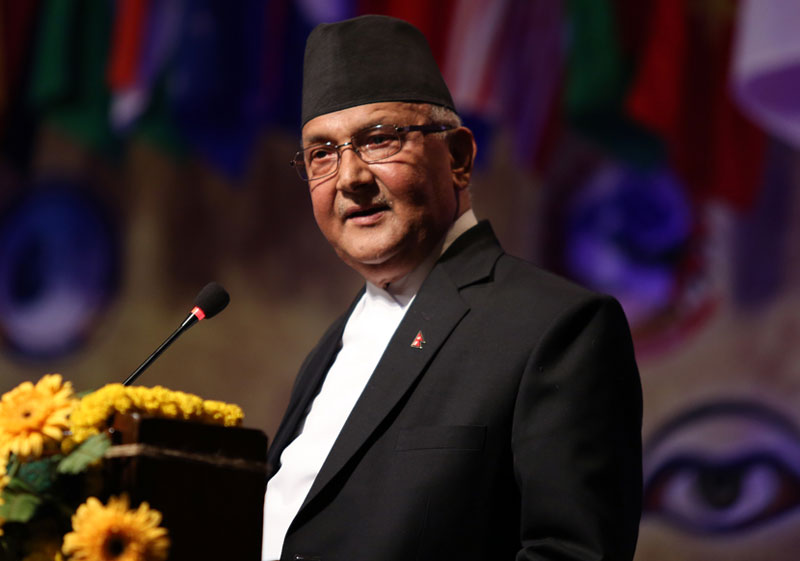 KP Sharma Oli, the chairman of CPM-UML has been sworn in as the 41st Prime Minister of the Federal Democratic Republic of Nepal after the conclusion of the elections. His administration now carries the responsibility of realizing the Nepali people’s long-cherished dream of development, political stability, and prosperity of the nation. At present, he has plans to form a formidable cabinet of experienced and capable ministers.
KP Sharma Oli, the chairman of CPM-UML has been sworn in as the 41st Prime Minister of the Federal Democratic Republic of Nepal after the conclusion of the elections. His administration now carries the responsibility of realizing the Nepali people’s long-cherished dream of development, political stability, and prosperity of the nation. At present, he has plans to form a formidable cabinet of experienced and capable ministers.
Despite the positive outlook many are realistic that the democratic elections are simply one summit the country has successfully climbed but there are more such summits for the country to overcome. How will the new government meet the demands of the Madhesh based parties to amend the constitution or bring the discontented parties within the framework of the constitution? How will it keep the nation, which is now divided into provinces, more united? How will it continue and address the complicated issues of reconstruction brought by the major earthquake that devastated Nepal in 2015? Some believe that the first term will only be a probation period for the government to learn and make adjustments for the next term. Moreover, it will be interesting to see how the Oli government will maintain the country’s foreign affairs, especially with regional powers China and India looming behind the scenes. Oli must also confront the challenges of maintaining the unity among the communist parties and fulfilling the election promises that the alliance made.
Making the Elections More Democratic, Fair and Inclusive
As far as the Election Commission of Nepal is concerned, the three-tier election was smoothly, fairly and peacefully concluded. Around 218,000 security personnel were deployed by the government just for the second phase of the parliamentary and provincial elections, augmented by 98,268 temporary police personnel. Besides few acts of violence, voting in most of the polls was peaceful. The women participation is also higher than past elections, thanks to the new constitution that mandates that at least two women should sit in each of the 700 ward committees, including a candidate from the Dalit community. Moreover, the constitution also mandates at least one woman candidate from the political parties for the positions of Mayor and Deputy Mayor in municipalities. Village Chairperson and Vice Chairperson positions in rural municipalities also require at least one woman candidate among the two.
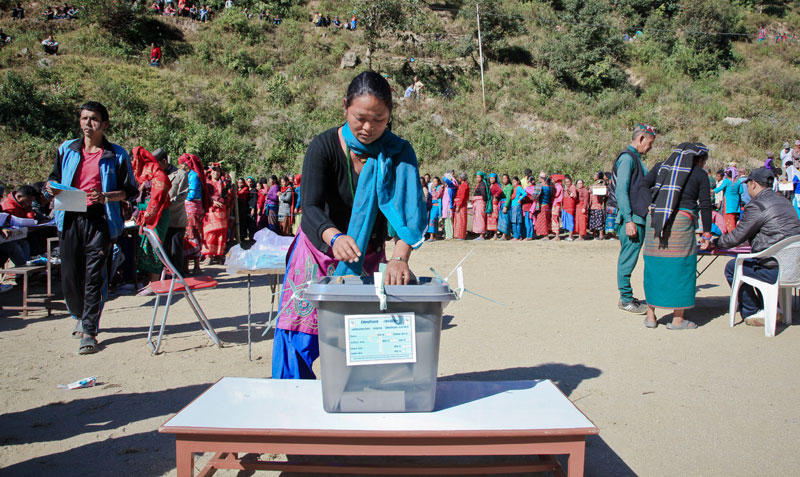 However, despite these positive legal reforms, ambiguities still exist and there is still a long way to go for Nepal to ensure that its elections are truly democratic, fair and inclusive. It has not been easy for women to use the opportunities provided by legislation (especially for the Dalits) due to lack of information about the election opportunities, procedures, and their rights. In some areas, “Dalits have no citizenship yet in the first place, [thus] restricting them from exercising their rights.” says Pema Rithar, a recently elected ward chairperson from Tsum, Nubri, a rural municipality that lies in the Northern part of Nepal.
However, despite these positive legal reforms, ambiguities still exist and there is still a long way to go for Nepal to ensure that its elections are truly democratic, fair and inclusive. It has not been easy for women to use the opportunities provided by legislation (especially for the Dalits) due to lack of information about the election opportunities, procedures, and their rights. In some areas, “Dalits have no citizenship yet in the first place, [thus] restricting them from exercising their rights.” says Pema Rithar, a recently elected ward chairperson from Tsum, Nubri, a rural municipality that lies in the Northern part of Nepal.
When asked about women participation in elections in his area, Rithar adds,
“It’s different in reality. Women are occupied with household work daily. They have to look after their children, prepare food and attend village work. Even if they have time, they don’t want to travel up and down in these hard geographies for official meetings. They would rather stay at home and do hotel business or sell local alcohol.”
Around 3.8 million Nepalis (excluding those in India), who are abroad as migrant workers, are still unable to vote despite some countries like Saudi Arab and Qatar agreeing to support voting mechanisms for the migrants. This case puts into question the inclusiveness of the election and worsens the problem of disinterest in politics of young Nepalis. Yubraj Nepal, a migration expert and a founder of Centre for Migration and International Relations (CMIR), points out,
“A big portion of population, especially youth aged 16-24, is excluded from [exercising] their voting rights just because they are abroad whereas their contribution in GDP of Nepal is around 32% and more than 60% of the household are benefiting from it. As the migrants are unable to vote or could not vote when they are abroad, most of the political parties do not consider their (migrant workers’) agenda to incorporate in their manifesto or address their problem. As an example, in the recent elections only one political party has addressed the migrant workers in their political manifesto.”
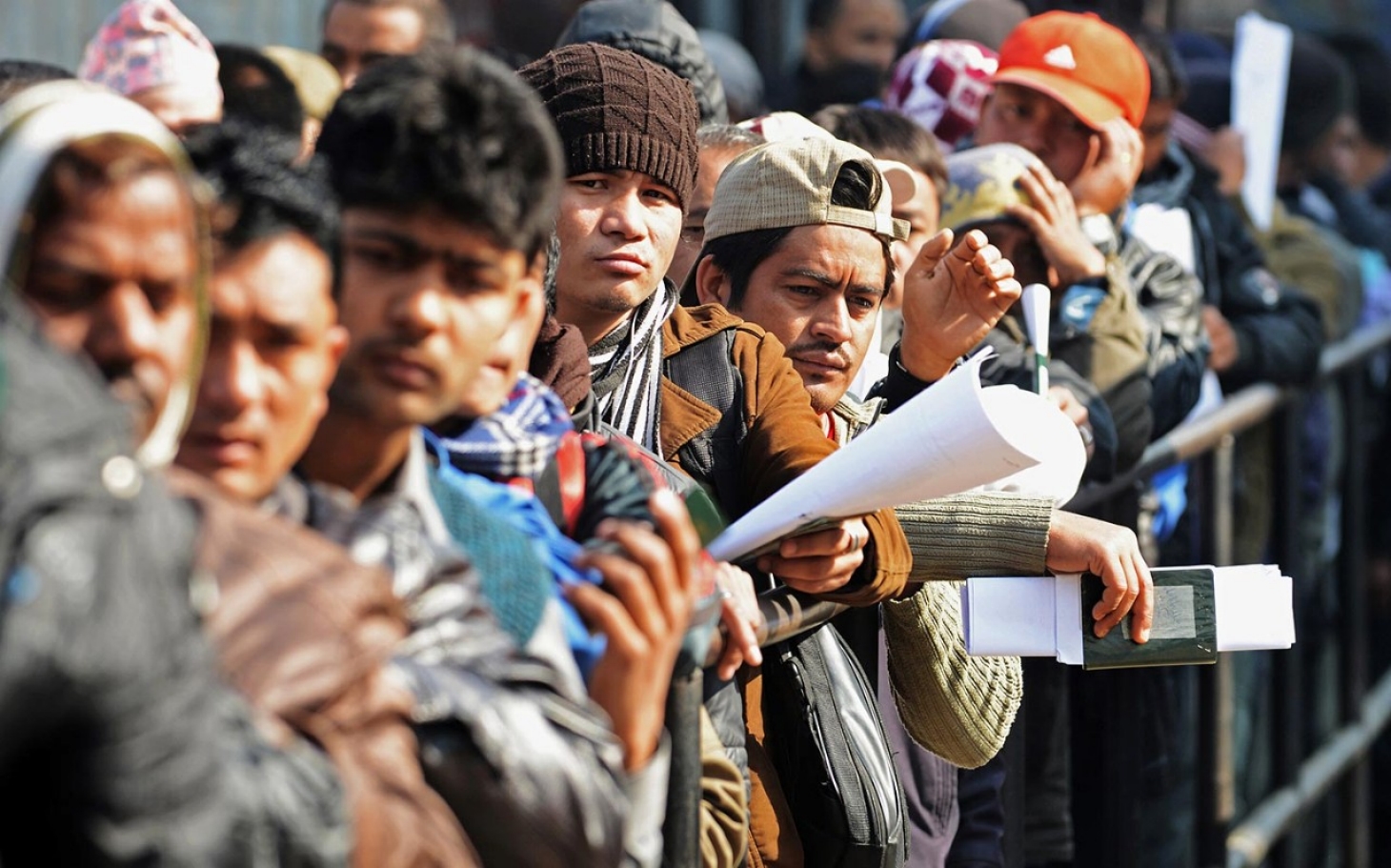 It is clear that policies and proper support mechanisms should be created to address these issues and challenges. Policies on legal arrangements and mechanisms for the migrant workers to register and participate in the polls should be in place to make the elections more inclusive.
It is clear that policies and proper support mechanisms should be created to address these issues and challenges. Policies on legal arrangements and mechanisms for the migrant workers to register and participate in the polls should be in place to make the elections more inclusive.
Then there are also issues of election financing wherein poor candidates are hard-pressed in competing against highly resourced candidates and parties.
Nepal, a country rich in diversity and pronounced as secular, is a shelter to around 15 thousand Tibetans for the past 60 years. However, the government of Nepal has failed to provide any legal status to them. As such they are restricted from formally participating in the elections. Furthermore, having not been legalized, they are likely to resort to illegal ways for survival that not only puts them vulnerable to criminal activities but also costs the government millions in tax revenues.
The country’s direction in greater recognition of women’s rights is remarkable. But progress can still be made. Inclusivity is not just about giving women 50% of government seats but also improving access to education and other opportunities. While the UN’s Sustainable Development goals on inclusion pledges to, “Leave no one behind” for many Nepalis the phrase, “leave no one behind with legal documents” is more true.
Nevertheless, Nepal’s step towards political stability has begun. The testing period for its ideal constitution has commenced. Looking forward, what one should really hope is that the country’s political parties learn and uphold a more modern electoral culture in their values and not just support the national elections to conform to the constitution. All Nepalis stand to benefit from the adoption of a more open political and electoral system, with fair rules for selection, transparency in government and good governance. This is a task for Nepal’s major political actors, whether in power or in the opposition. Such values will no doubt inspire the younger generations of Nepal to engage in politics and governance. But for now, the promulgation of the new federal constitution and the successful conclusion of the three-tier elections are just achievements and have yet to show whether they will have a positive outcome and prove to be a landmark in the Himalayan nation’s political history.
Pictures Sources:
1) KP Oli
File Source: The Himalayan Times
Reference: (The Himalayan Times, 2018)
2) Local Voting
File Source : My Republic
Reference: (My Republica, 2016)
3) Provincial Map of Nepal
File Source : Election Commission of Nepal
Reference : (Election Commission Nepal, 2018)
4) Aspiring migrant workers lining up for documentation
File Source: Nepal24Hrs.com
Reference : (Nepal24Hours.com, 2018)
References
Adhikari, B., 2015. Salient Features of the Constitution of Nepall 2015 (2072). [Online]
Available at: http://bipinadhikari.com.np/quick_comments_ind.php?id=76
[Accessed 20 02 2018].
Aljazeera, 2017. Nepal Elections Explained. [Online]
Available at: https://www.aljazeera.com/indepth/interactive/2017/11/nepal-elections-2017-explained-171126103009857.html
[Accessed 20 02 2018].
Aljazeera, 2017. Nepal voes in Key general elections. [Online]
Available at: https://www.aljazeera.com/news/2017/11/nepal-gears-key-election-171125103625452.html
[Accessed 22 02 2018].
Aljazeera, 2017. Nepal votes in first local elections in 20 years. [Online]
Available at: https://www.aljazeera.com/news/2017/05/nepal-votes-local-elections-20-years-170514041324775.html
[Accessed 19 02 2018].
Anon., 2017. The Tale of One Tibetan Refugee in Nepal: Memories, Insecurity and Home. [Online]
Available at: http://utsynergyjournal.org/2017/05/06/the-tale-of-one-tibetan-refugee-in-nepal-memories-insecurity-and-home/
[Accessed 25 02 2018].
DD News, 2017. US congratulates Nepal for successful elections. [Online]
Available at: http://www.ddinews.gov.in/international/us-congratulates-nepal-successful-elections
[Accessed 21 02 2018].
Election Commission Nepal, 2018. Local Level Election, House of Representatives, Provincial Assembly Elections and National Assembly, 2017 Vote Count Results. [Online]
Available at: http://result.election.gov.np/
[Accessed 25 02 2018].
Election Commission Nepal, n.d. http://www.election.gov.np/election/en/register-to-vote-56.html. [Online]
Available at: http://www.election.gov.np/election/en/register-to-vote-56.html
[Accessed 25 02 2018].
Hindustantimes, 2017. Prominent Madhesi party to boycott second phase of Nepal local polls. [Online]
Available at: https://www.hindustantimes.com/world-news/prominent-madhesi-party-to-boycott-second-phase-of-nepal-local-polls/story-E2QNaZmpq877qDyyjMjZaO.html
[Accessed 22 02 2018].
Ministry of Law, Justice and Parliamentary Affairs Nepal, 2015. The constitution of Nepal : Preamble. [Online]
Available at: http://www.wipo.int/edocs/lexdocs/laws/en/np/np029en.pdf
[Accessed 25 02 2018].
My Republica, 2016. Three Elections by December 2017? Good Luck!. [Online]
Available at: http://www.myrepublica.com/news/4474/
[Accessed 21 02 2018].
My Republica, 2017. Controversies, deaths and polls sum up Nepal's 2017. [Online]
Available at: http://election.nagariknews.com/news/33512/en
[Accessed 22 02 2018].
My Republica, 2017. EC reports 65% voter turnout. [Online]
Available at: http://election.nagariknews.com/news/31543/en
[Accessed 22 02 2018].
Pokhrel, A., 2017. Local elections: a step for strengthening democracy in Nepal?. [Online]
Available at: https://www.peaceinsight.org/blog/2017/07/local-elections-step-strengthening-democracy-nepal/
[Accessed 24 02 2018].
Ranjan, A., 2015. Federalism in Nepal : Why and what it means ? An attempt to clarify misconceptions.. [Online]
Available at: http://www.madhesiyouth.com/political/federalism-in-nepal-why-and-what-it-means-an-attempt-to-clarify-misconceptions/
[Accessed 20 02 2018].
Shreejana Shrestha, 2016. Fewer Tibetan Refugees. [Online]
Available at: http://www.nepalitimes.com/blogs/thebrief/2016/06/14/fewer-tibetan-refugees/
[Accessed 23 02 2018].
The Diplomat, 2015. Nepal's New Constitution: 65 years in the making. [Online]
Available at: https://thediplomat.com/2015/09/nepals-new-constitution-65-years-in-the-making/
[Accessed 19 02 2018].
The Himalayan Times, 2018. Know your Prime Minister. [Online]
Available at: https://thehimalayantimes.com/kathmandu/know-prime-minister/
[Accessed 21 02 2018].
The Kathmandu Post, 2017. Election 2017. [Online]
Available at: https://election.ekantipur.com/?lng=eng
[Accessed 20 02 2018].
The Kathmandu Post, 2017. Govt plans to deploy 60,000 security forces in 8 districts. [Online]
Available at: http://kathmandupost.ekantipur.com/printedition/news/2017-11-29/govt-plans-to-deploy-60000-security-forces-in-8-districts.html
[Accessed 22 02 2018].
The Rising Nepal, 2017. For Free And Fair Local Election. [Online]
Available at: http://therisingnepal.org.np/news/17682
[Accessed 19 02 2018].
The Rising Nepal, 2017. Importance of Local Elections. [Online]
Available at: http://therisingnepal.org.np/news/11227
[Accessed 20 02 2018].
UNDP Nepal, 2017. More women on the political frontlines. [Online]
Available at: http://www.np.undp.org/content/nepal/en/home/presscenter/articles/2017/09/05/more-women-on-the-political-frontlines.html
[Accessed 25 02 2018].
United Nations, n.d. Ensuring that no one is left behind: Envisioning an inclusive world in 2030. [Online]
Available at: https://sustainabledevelopment.un.org/index.php?page=view&type=20000&nr=291&menu=2993
[Accessed 22 02 2018].